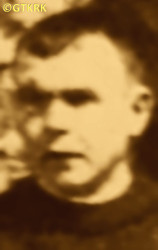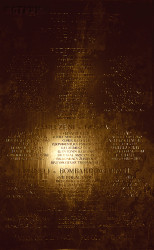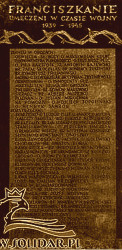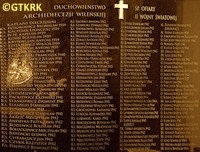Roman Catholic
St Sigismund parish
05-507 Słomczyn
85 Wiślana Str.
Konstancin deanery
Warsaw archdiocese, Poland
full list:
displayClick to display full list

searchClick to search full list by categories
wyświetlKliknij by wyświetlić pełną listę po polsku

szukajKliknij by przeszukać listę wg kategorii po polsku

Martyrology of the clergy — Poland
XX century (1914 – 1989)
personal data
surname
ONOSZKO
forename(s)
Vladislav (pl. Władysław)
religious forename(s)
Constantine (pl. Konstanty)
function
religious cleric
creed
Latin (Roman Catholic) Church RCmore on
en.wikipedia.org
[access: 2014.09.21]
congregation
Order of Friars Minor Conventual OFMConvmore on
en.wikipedia.org
[access: 2013.05.19]
(i.e. Conventual Franciscans)
diocese / province
Immaculate Mary province OFMConvmore on
pl.wikipedia.org
[access: 2014.08.18]
st Anthony of Padua and bl. James Strzemię province OFMConvmore on
pl.wikipedia.org
[access: 2014.08.18]
academic distinctions
Doctor of Theology
date and place
of death
07.01.1942

Slonimtoday: Slonim dist., Grodno reg., Belarus
more on
en.wikipedia.org
[access: 2021.09.29]
alt. dates and places
of death
24.06.1941, 10.1941, 14.10.1942
Shchuchynalso: Lithuanian Shchuchyn
today: Shchuchyn dist., Grodno reg., Belarus
more on
en.wikipedia.org
[access: 2022.09.17]
details of death
After German and Russian invasion of Poland in 09.1939 and start of the World War II, after start of Russian occupation survived murderous attack of Commie‐Nazi Belarusian band on his rectory (Belarusians axed to death the local Zaczepice commune's mayor, among others).
After German attack on 22.06.1941 of their erstwhile ally, Russians, falsely accused by an Orthodox priest — in retaliation for blessings given to mixed Orthodox and Catholic marriages — and arrested by the Germans in Navahrudak.
Brought to Slonim prison.
There tortured.
Finally driven out and murdered in an unknown location.
The church in Ruda Yavarskaya was appropriated by the aforementioned Orthodox priest.
alt. details of death
According to other sources from Baranavichy prison brought to Shchuchyn in Lida deanery and there hanged.
According to yet another sources arrested earlier, by the Russians, and murdered in Baranavichy during their panic escape and genocidal prison murdered after German attack on 22.06.1941 of their erstwhile ally, Russians.
cause of death
murder
perpetrators
Germans / Russians
sites and events
06.1941 massacres (NKVD)Click to display the description, Ribbentrop‐MolotovClick to display the description, Pius XI's encyclicalsClick to display the description
date and place
of birth
22.12.1902

Zastaryntsitoday: Myory ssov., Myory dist., Vitebsk reg., Belarus
more on
be.wikipedia.org
[access: 2023.01.18]
alt. dates and places
of birth
Myorytoday: Myory dist., Vitebsk reg., Belarus
more on
en.wikipedia.org
[access: 2024.03.19]
religious vows
02.10.1927 (temporary)
04.10.1930 (permanent)
presbyter (holy orders)
ordination
07.06.1931

Lvivtoday: Lviv urban hrom., Lviv rai., Lviv obl., Ukraine
more on
en.wikipedia.org
[access: 2022.01.16]
positions held
1938 – 1941
guardian — Zachepichitoday: Orlya ssov., Shchuchyn dist., Grodno reg., Belarus
more on
be.wikipedia.org
[access: 2022.10.26] ⋄ St Peter and St Paul the Apostles monastery, Conventual Franciscans OFMConv
1938 – 1941
curatus/rector/expositus — Zachepichitoday: Orlya ssov., Shchuchyn dist., Grodno reg., Belarus
more on
be.wikipedia.org
[access: 2022.10.26] ⋄ Conventual Franciscans OFMConv ⋄ St Peter and St Paul the Apostles RC chapel ⋄ Žaludoktoday: Žaludok ssov., Shchuchyn dist., Grodno reg., Belarus
more on
be.wikipedia.org
[access: 2022.10.26], Assumption of the Blessed Virgin Mary RC parish ⋄ Lidatoday: Lida dist., Grodno reg., Belarus
more on
en.wikipedia.org
[access: 2021.09.29] RC deanery
1938 – 1941
curatus/rector/expositus — Ruda Yavorskayatoday: Khvinevichi ssov., Dzyatlava dist., Grodno reg., Belarus
more on
be.wikipedia.org
[access: 2022.10.26] ⋄ Immaculate Conception of the Blessed Virgin Mary RC church ⋄ Dzyatlavatoday: Dzyatlava dist., Grodno reg., Belarus
more on
en.wikipedia.org
[access: 2022.01.06], Assumption of the Blessed Virgin Mary RC parish ⋄ Dzyatlavatoday: Dzyatlava dist., Grodno reg., Belarus
more on
en.wikipedia.org
[access: 2022.01.06] RC deanery
1937 – 1938
friar — Rometoday: Rome prov., Lazio reg., Italy
more on
en.wikipedia.org
[access: 2021.12.18] ⋄ Twelve Apostles monastery, Conventual Franciscans OFMConv — penitentiary–confessor in the St Peter Basilica
1936 – 1937
guardian — Jasłotoday: Jasło urban gm., Jasło pov., Subcarpathia voiv., Poland
more on
en.wikipedia.org
[access: 2021.10.09] ⋄ St Anthony of Padua monastery, Conventual Franciscans OFMConv — prefect of the school of commerce and retreatist
1933 – 1936
friar — Poznańtoday: Poznań city pov., Greater Poland voiv., Poland
more on
en.wikipedia.org
[access: 2021.07.18] ⋄ monastery (on Przemysł Hill), Conventual Franciscans OFMConv — retreat preacher and missionary
1932 – 1933
friar — Nagasakitoday: Nagasaki pref., Kiusiu reg., Japan
more on
en.wikipedia.org
[access: 2022.10.26] ⋄ Conventual Franciscans OFMConv — missionary
1931 – 1932
friar — Vilniustoday: Vilnius city dist., Vilnius Cou., Lithuania
more on
en.wikipedia.org
[access: 2022.01.06] ⋄ Assumption of the Blessed Virgin Mary monastery, Conventual Franciscans OFMConv
till 1932
PhD student — Vilniustoday: Vilnius city dist., Vilnius Cou., Lithuania
more on
en.wikipedia.org
[access: 2022.01.06] ⋄ Department of Theology, Stephen Batory University [i.e. Vilnius University (from 1945) / some faculties acting clandestinely (1939‐1945) / closed by Lithuanians (1939) / Stephen Batory University (1919‐1939)]
1927 – 1931
friar — Lvivtoday: Lviv urban hrom., Lviv rai., Lviv obl., Ukraine
more on
en.wikipedia.org
[access: 2022.01.16] ⋄ Immaculate Conception of the Blessed Virgin Mary monastery, Conventual Franciscans OFMConv — i.a. chaplain of the „Health Fund” sanatorium
1928 – 1931
student — Lvivtoday: Lviv urban hrom., Lviv rai., Lviv obl., Ukraine
more on
en.wikipedia.org
[access: 2022.01.16] ⋄ philosophy and theology, Department of Theology, John Casimir University [i.e. clandestine John Casimir University (1941‐1944) / Ivan Franko University (1940‐1941) / John Casimir University (1919‐1939) / Franciscan University (1817‐1918)]
01.10.1926 – 02.10.1927
novitiate — Łagiewnikitoday: neighborhood in Łódź city, Łódź city pov., Łódź voiv., Poland
more on
en.wikipedia.org
[access: 2021.07.18] ⋄ St Anthony of Padua and St John the Baptist monastery, Conventual Franciscans OFMConv
1925 – 1926
student — Vilniustoday: Vilnius city dist., Vilnius Cou., Lithuania
more on
en.wikipedia.org
[access: 2022.01.06] ⋄ philosophy and theology, Theological Seminary — 3rd year
Catholic journalist
others related
in death
SOBOLEWSKIClick to display biography Steven (Fr Pacific Mary)
sites and events
descriptions
06.1941 massacres (NKVD): After German attack of Russian‐occupied Polish territory and following that of Russia itself, before a panic escape, Russians murdered — in accordance with the genocidal order issued on 24.06.1941 by the Russian interior minister Lawrence Beria to murder all prisoners (formally „sentenced” for „counter‐revolutionary activities”, „anti‐Russian acts”, sabotage and diversion, and political prisoners „in custody”), held in NKVD‐run prisons in Russian occupied Poland, Lithuania, Latvia and Estonia — c. 40,000‐50,000 prisoners. In addition Russians murdered many thousands of victims arrested after German attack regarding them as „enemies of people” — those victims were not even entered into prisons’ registers. Most of them were murdered in massacres in the prisons themselves, the others during so‐called „death marches” when the prisoners were driven out east. After Russians departure and start of German occupation a number of spontaneous pogroms of Jews took place. Many Jews collaborated with Russians and were regarded as co‐responsible for prison massacres. (more on: en.wikipedia.orgClick to attempt to display webpage
[access: 2021.12.19])
Ribbentrop‐Molotov: Genocidal Russian‐German alliance pact between Russian leader Joseph Stalin and German leader Adolf Hitler signed on 23.08.1939 in Moscow by respective foreign ministers, Mr. Vyacheslav Molotov for Russia and Joachim von Ribbentrop for Germany. The pact sanctioned and was the direct cause of joint Russian and German invasion of Poland and the outbreak of the World War II in 09.1939. In a political sense, the pact was an attempt to restore the status quo ante before 1914, with one exception, namely the „commercial” exchange of the so‐called „Kingdom of Poland”, which in 1914 was part of the Russian Empire, fore Eastern Galicia (today's western Ukraine), in 1914 belonging to the Austro‐Hungarian Empire. Galicia, including Lviv, was to be taken over by the Russians, the „Kingdom of Poland” — under the name of the General Governorate — Germany. The resultant „war was one of the greatest calamities and dramas of humanity in history, for two atheistic and anti‐Christian ideologies — national and international socialism — rejected God and His fifth Decalogue commandment: Thou shall not kill!” (Abp Stanislav Gądecki, 01.09.2019). The decisions taken — backed up by the betrayal of the formal allies of Poland, France and Germany, which on 12.09.1939, at a joint conference in Abbeville, decided not to provide aid to attacked Poland and not to take military action against Germany (a clear breach of treaty obligations with Poland) — were on 28.09.1939 slightly altered and made more precise when a treaty on „German‐Russian boundaries and friendship” was agreed by the same murderous signatories. One of its findings was establishment of spheres of influence in Central and Eastern Europe and in consequence IV partition of Poland. In one of its secret annexes agreed, that: „the Signatories will not tolerate on its respective territories any Polish propaganda that affects the territory of the other Side. On their respective territories they will suppress all such propaganda and inform each other of the measures taken to accomplish it”. The agreements resulted in a series of meeting between two genocidal organization representing both sides — German Gestapo and Russian NKVD when coordination of efforts to exterminate Polish intelligentsia and Polish leading classes (in Germany called «Intelligenzaktion», in Russia took the form of Katyń massacres) where discussed. Resulted in deaths of hundreds of thousands of Polish intelligentsia, including thousands of priests presented here, and tens of millions of ordinary people,. The results of this Russian‐German pact lasted till 1989 and are still in evidence even today. (more on: en.wikipedia.orgClick to attempt to display webpage
[access: 2015.09.30])
Pius XI's encyclicals: Facing the creation of two totalitarian systems in Europe, which seemed to compete with each other, though there were more similarities than contradictions between them, Pope Pius XI issued in 03.1937 (within 5 days) two encyclicals. In the „Mit brennender Sorge” (Eng. „With Burning Concern”) published on 14.03.1938, condemned the national socialism prevailing in Germany. The Pope wrote: „Whoever, following the old Germanic‐pre‐Christian beliefs, puts various impersonal fate in the place of a personal God, denies the wisdom of God and Providence […], whoever exalts earthly values: race or nation, or state, or state system, representatives of state power or other fundamental values of human society, […] and makes them the highest standard of all values, including religious ones, and idolizes them, this one […] is far from true faith in God and from a worldview corresponding to such faith”. On 19.03.1937, published „Divini Redemptoris” (Eng. „Divine Redeemer”), in which criticized Russian communism, dialectical materialism and the class struggle theory. The Pope wrote: „Communism deprives man of freedom, and therefore the spiritual basis of all life norms. It deprives the human person of all his dignity and any moral support with which he could resist the onslaught of blind passions […] This is the new gospel that Bolshevik and godless communism preaches as a message of salvation and redemption of humanity”… Pius XI demanded that the established human law be subjected to the natural law of God , recommended the implementation of the ideal of a Christian state and society, and called on Catholics to resist. Two years later, National Socialist Germany and Communist Russia came together and started World War II. (more on: www.vatican.vaClick to attempt to display webpage
[access: 2023.05.28], www.vatican.vaClick to attempt to display webpage
[access: 2023.05.28])
sources
personal:
biographies.library.nd.eduClick to attempt to display webpage
[access: 2015.05.09], onoszko-ludwika.blogspot.comClick to attempt to display webpage
[access: 2017.11.07]
bibliographical:
„Vilnius archdiocese clergy martyrology 1939‐1945”, Fr Thaddeus Krahel, Białystok, 2017
„Biographical–bibliographical dictionary of Polish Conventual Franciscan Fathers murdered and tragically dead in 1939‐1945”, Lukas Janecki, Franciscan Fathers’ Publishing House, Niepokalanów, 2016
original images:
www.sowiniec.com.plClick to attempt to display webpage
[access: 2014.07.11], ipn.gov.plClick to attempt to display webpage
[access: 2019.02.02], www.ciekawepodlasie.plClick to attempt to display webpage
[access: 2020.07.31]
LETTER to CUSTODIAN/ADMINISTRATOR
If you have an Email client on your communicator/computer — such as Mozilla Thunderbird, Windows Mail or Microsoft Outlook, described at WikipediaPatrz:
en.wikipedia.org, among others — try the link below, please:
LETTER to CUSTODIAN/ADMINISTRATORClick and try to call your own Email client
If however you do not run such a client or the above link is not active please send an email to the Custodian/Administrator using your account — in your customary email/correspondence engine — at the following address:

giving the following as the subject:
MARTYROLOGY: ONOSZKO Vladislav
To return to the biography press below:
 Click to return to biography
Click to return to biography













